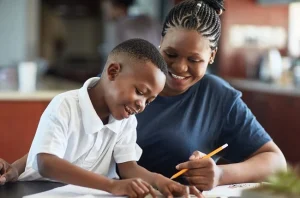
Parent Playbooks
The Parent Playbooks are a collection of expert-approved resources focused on addressing bullying and cultivating mental wellness, kindness, and empathy.

Check out our NEW toolkits and guides! Below you'll find a thoughtfully created collection of expert-approved, step-by-step resources to support you in your situation.

The Parent Playbooks are a collection of expert-approved resources focused on addressing bullying and cultivating mental wellness, kindness, and empathy.

The Educator and Coach Toolkit is a collection of expert-approved resources focused on understanding, preventing and responding to bullying.
Find actionable resources from The Choose Kindness Alliance — a coalition of the nation’s leading nonprofit organizations — focusing on bullying prevention, intentional inclusion and youth mental wellness.
Bullying is a pattern of intentionally aggressive behavior meant to harm or humiliate someone. When it happens online, it’s called cyberbullying and it is no less serious than when it happens in person. It’s also common. Almost 60% of teens have been bullied online.
What cyberbullying looks like:
Someone shares content meant to shame or embarrass another person through social media, text messages, emails, online forums, gaming platforms and other digital spaces. Examples include:
Someone you know may be being cyberbullied if they:
If you notice any of these or other significant changes in how someone you love acts or functions, check in with them to find out what’s going on and how you can help.
Cyberbullying should be taken as seriously as in-person bullying, because it can have the same negative impacts on a person’s mental health, including:
Some basic steps to take if someone you know is being cyberbullied:
Learn more ways you and your loved one can cope with cyberbullying.
Ask your loved one if they have thought about suicide and then get them help.
Laura Erickson-Schroth, MD, Chief Medical Officer of The Jed Foundation
Coaches play an incredibly influential role in the lives of athletes. Often players spend more time with their coaches than anyone else outside of the home environment. Creating an environment that is physically, emotionally, and psychologically safe for ALL athletes is one of the most important responsibilities of a coach. This environment also supports best possible performance.
Here are three key steps to creating this environment:
“A caring climate is an environment that is inviting, psychologically safe, supportive, and able to provide the experience of being valued and respected. A place where everyone is treated with mutual kindness and respect and is able to perform well.” -Dr. Mary Fry
Positive Coaching Alliance offers many resources and research-based trainings to help coaches, parents, athletes and caring adults ensure a positive youth development experience.
This is such a hard situation for you and your child! Our response (and yours!) depends on a number of factors, including: age, if the child has special needs or an Individualized Educational Plan, or IEP, cause of the exclusion, the type of behavior, whether the school has a bullying prevention policy.
First, let your child know you believe them and assure them you are working toward making their experience better at school and you are there to listen and support. If you haven’t done so already, reach out to your child’s school counselor to make sure they are aware of the situation and request, in writing, a meeting with the teacher, principal, and school counselor to identify solutions. It is likely that there is a bullying prevention policy and a formal process to report bullying activity. Most policies require a formal response, so this can be an important step. It is crucial to document what your child says and all calls and actions taken to bring it to the school’s attention and their responses. Partnering with a community advocacy group may be helpful if one is available.
When you meet, ask about how the school approaches social inclusion and tell your child’s story. If your child has an IEP, you might also want to call an IEP meeting to discuss the situation. If your child’s IEP has social skill goals, ensure that social activities are provided by the school to help your child develop and practice those skills.
Strategies like Special Olympics Unified Champion Schools and other proactive social inclusion activities help create a healthy school climate in which all students, with and without disabilities, feel they belong and help to reduce bullying. Inclusive programming in which all students are part of sports teams, clubs and other school-wide activities encourages students to get to know each other’s unique abilities. Your child’s school and teachers can be encouraged to learn about and offer a more inclusive experience for all students and to conduct classroom discussions and lessons around being an inclusive leader, values of kindness, inclusion, belonging, identity, understanding differences, and seeing everyone for their strengths. Reaching out to parents who share your concerns or are involved in improving the school overall can also be helpful. Engage all children in advocating for each other so that everyone learns, plays and leads together at school. Friends and connections with caring adults and peers at school are one of the biggest factors in preventing bullying.
We find that students want to be kind if given the tools. As Tajha Ilerant, a Special Olympics Unified leader who was bullied in her school, says “You know how it feels to be excluded and not welcome. And you want that to change. When I think about it, it makes me cry, because I want to know what I can do to make this not happen, to make sure everyone is included, and feeling loved.”
Empathy is the common thread that can change overall bullying behavior. Research consistently shows that we can enhance empathy skills by teaching, practicing and reinforcing skills that lead to empathy early in life. Using books and other resources that positively show diverse families and individuals that are different from the experiences of each youth will create an opportunity to not only appreciate differences but embrace them.
Cheryl Greene (she/her) M.S.Ed. Director, Welcoming Schools Human Rights Campaign Foundation
Over time, racism has looked different. In some ways, it means creating separate spaces or having different items for people of different races to use. Today, racism may look like someone picking on, insulting, or being physically aggressive to someone else because of their race. It can include calling people names, racial slurs, yelling at others in public, or saying hurtful, untrue things about people based on their race in-person or online. It may look like excluding people from an activity because of their race.
Racism may also present in subtle ways to a child, like making fun of someone’s name, hair style, clothing, or food that’s connected with their race or religion. From media and stories, we’ve heard the ways Asian American students and adults false accusations of stereotypes and assumptions around their race, from being called terrorists, to carriers of the COVID-19 virus and to not “belonging” in the United States and the need to “return to their country.”
Act to Change has worked with youth to develop the “Racism is a Virus Toolkit” which includes more examples and the history of racism against Asian Americans as well as steps to address or create change to combat racism.
At the National School Climate Center at Ramapo, we advise adults to focus on four key ideas when building an inclusive learning environment.
First, develop positive relationships and create opportunities for young people to connect with each other and with the adults in their community. While an adult may not agree with every action a young person takes, it is essential to connect with each of them with care during each interaction.
Second, practice self-awareness and mindfulness with young people by supporting them in identifying the connection between feelings and actions, and understanding how we respond to conflict. At NSCC at Ramapo, we use Dr. Daniel Siegel’s “Hand Model of the Brain” to help young people understand how their actions are connected to their emotions. When conflicts do inevitably occur, we encourage everyone involved (including adults) to take time to cool off. When everyone is calm, find a quiet place to have a conversation to explore and understand what happened, the impact of the situation, and what everyone can do differently the next time. The adult must model social and emotional skills such as admitting mistakes and matching their voice and body language to their message.
Third, we encourage adults to provide opportunities for young people to experience success. All young people have talents, and by finding ways for each person to feel successful and share their talents and expertise with the class, they can feel more connected to others in their community. Finding opportunities to listen to young people – without an agenda – can support adults in discovering the gifts, strengths and ideas that young people bring.
Finally, help each person make meaning and find purpose. Adults can support young people in connecting what they are learning to their lives and goals. This is a chance to make the “why” of systems and expectations clear, and help young people see the impact of their learning, growth and reflection in the future.
If you or a loved one is needing immediate support services, please contact an emergency service line right away.
In an emergency, dial 911 from your phone immediately. An emergency is any situation that requires immediate assistance from the police, fire department or ambulance.
The 988 Suicide & Crisis Lifeline offers 24/7 call, text and chat access to trained crisis counselors who can help people who are experiencing suicidal, substance use and/or mental health crisis, or any other kind of emotional distress.
Navigating these challenges can be difficult and confusing. Learn how other parents and caring adults are working to prevent bullying and build inclusion.